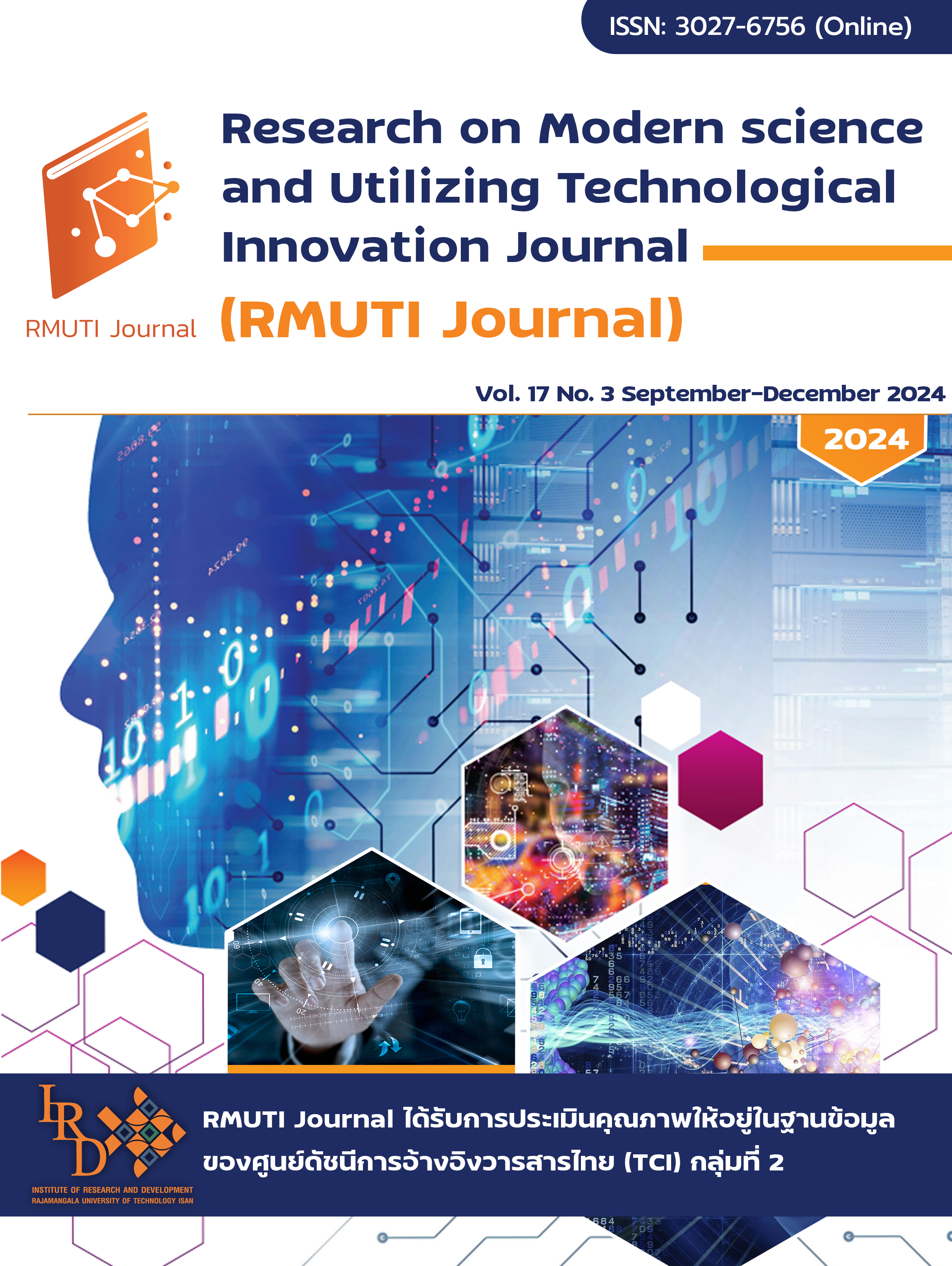การผลิตแป้งทนย่อยจากแป้งถั่วโดยการหมักร่วมกับพลูลูลาเนสและการเกิดรีโทรเกรเดชัน
Main Article Content
บทคัดย่อ
งานวิจัยนี้มีวัตถุประสงค์เพื่อศึกษาผลของการหมักร่วมกับการใช้พลูลูลาเนสและการเกิดรีโทรเกรเดชันต่อปริมาณและคุณสมบัติของแป้งทนย่อยด้วยเอนไซม์ (Resistant Starch: RS) ในแป้งถั่ว โดยหมักแป้งฟลาวถั่ว (ถั่วเขียว ถั่วแดง และถั่วเหลือง) ด้วยการหมักธรรมชาติเป็นเวลา 1 วัน จากนั้นนำแป้งฟลาวถั่วที่ผ่านกระบวนการหมักมาตัดพันธะ -1,6-Glycosidic Linkages ด้วยพลูลูลาเนส (40 ยูนิตต่อกรัม) ที่อุณหภูมิ 50 องศาเซลเซียส เป็นเวลา 12 24 36 และ 48 ชั่วโมง เมื่อเปรียบเทียบระดับการย่อยด้วยพลูลูลาเนส พบว่า ระยะเวลาการบ่มเอนไซม์ที่เหมาะสมคือ 24 ชั่วโมง เมื่อนำฟลาวถั่วหมักที่ผ่านการตัดพันธะกิ่งมาบ่มที่อุณหภูมิ 4 องศาเซลเซียส เป็นเวลา 1 3 5 7 และ 14 วัน พบว่าระยะเวลาการเกิดรีโทรเกรเดชันที่เหมาะสมคือ 14 วัน ซึ่งมีปริมาณ RS สูงที่สุด เมื่อนำแป้งทนย่อยของถั่วที่ผ่านการดัดแปร ศึกษาลักษณะรูปร่างของเม็ดแป้งด้วยเครื่อง Scanning Electron Microscope (SEM) ไม่พบลักษณะเม็ดแป้ง และมีรูปร่างไม่แน่นอน เมื่อศึกษาโครงสร้างผลึก ด้วยเครื่อง X-Ray Diffractometer (XRD) พบว่าแป้งทนย่อยของถั่วทั้ง 3 ชนิด มีรูปร่างผลึกแบบ A จากผลการทดลองพบว่ากระบวนการที่ใช้ในการดัดแปรแป้งทำให้ได้ปริมาณ RS เพิ่มขึ้น และลักษณะเม็ดแป้งและโครงสร้างผลึกที่เปลี่ยนแปลงไปทำให้ได้แป้งทนย่อยที่มีความหลากหลายที่จะนำไปประยุกต์ใช้เป็นส่วนประกอบของอาหารเพื่อสุขภาพได้
Article Details

This work is licensed under a Creative Commons Attribution-NonCommercial-NoDerivatives 4.0 International License.
References
Punbusayakul, N. (1999). Utilization of Defatted Soy Flour For Partial Replacing of Wheat Flour Chiffon Cake. Food. Vol. 29, No. 3, pp. 180-186 (in Thai)
Wianggwalai, H. and Phuwong, K. (2018). Effect of Red Bean Flour Substituted for Wheat Flour on Physicochemical Properties and Free Radical Scavenging Activities in Steamed Bun (Mantou). Thai Journal of Science and Technology. Vol. 7, Supplement 5, pp. 534-543. (in Thai) DOI: 10.14456/tjst.2018.48
Boonkong, J. (2011). Resistant Starch. Journal of Food Technology, Siam University. Vol. 6, No. 1, pp. 1-8 (in Thai)
Phrukwiwattanakul, P. (2013). Production of Resistant Starch from Different Types of Starch and Determination of Their Prebiotic Properties. Master Degree of Science in Food Technology, Prince of Songkla University (in Thai)
Udomrati, S., Satmalee, P., and Surojanametakul, V. (2015). Production of Resistant Starch from Rice Flour by Fermentation and Hydrothermal Treatment. KKU Science Journal. Vol. 43, No. 2, pp. 232-248 (in Thai)
Rattanasuwan, S. and Chotineeranat, S. (2018). Effect of Production Resistant Starch by Using Pullulanase Enzyme and Retrogradation with Heat-Moisture Treatment on Legume Starch. Phranakhon Rajabhat Research Journal: Science and Technology. Vol. 13, No. 2, pp. 133-145 (in Thai)
Shin, S., Byun, J., Park, K. H., and Moon, T. W. (2004). Effect of Partial Acid Hydrolysis and Heat-Moisture Treatment on Formation of Resistant Tuber Starch. Cereal Chemistry. Vol. 81, No. 2, pp. 194-198. DOI: 10.1094/CCHEM.2004.81.2.194
Juliano, B. O. (1971). A Simplified Assay for Milled Rice Amylose. Cereal Science Today. Vol. 16, No. 10, pp. 334-338
Miller, G. (1959). Use of Dinitrosalicylic Acid Reagent for Determination of Reducing Sugars. Analytical Chemistry. Vol. 31, No. 3, pp. 426-428. DOI: 10.1021/ac60147a030
Dubois, M., Gilles, K. A., Hamitton, J. K., Rebers, P. A., and Smith, F. (1956). Colorimetric Method For Determination of Sugars and Related Substances. Analytical Chemistry. Vol. 28, No. 3, pp. 350-356. DOI: 10.1021/ac60111a017
AOAC. (2000). Official Methods of Analysis Association of Official Analytical Chemist. Washington D.C.
Granito, M. and Álvarez, G. (2006). Lactic Acid Fermentation of Black Bean (Phaseolus Vulgaris): Microbiological and Chemical Characterization. Journal of the Science of Food and Agriculture. Vol. 86, pp. 1164-1171. DOI: 10.1002/jsfa.2490
Yadav, B. S., Sharma, A., and Yadav, R. B. (2007). Study of Effect of Natural Fermentation on The Resistant Starch Content of Legume Based Fermented Foods. Journal of Agricultural Technology. Vol. 3, No. 1, pp. 21-27
Setiarto, R. H. B., Jenie, B. S. L., Faridah, D. N., Sakiawan, I., and Sulistiani. (2018). Effect of Lactic Acid Bacteria Fermentation and Autoclaving-Cooling for Resistant Starch and Prebiotic Properties of Modified Taro Flour. International Food Research Journal. Vol. 25, No. 4, pp. 1691-1697
Pongjanta, J., Utaipatanacheep, A., Naivikul, O., and Piyachomkwan, K. (2008). Enzymes-Resistant Starch (RS III) from Pullulanase-Debranched High Amylose Rice Starch. Agricultural and Natural Resources. Vol. 42, No. 5, pp. 198-205
González-Soto, R. A., Agama-Acevedo, E., Solorza-Feria, J., Rendón-Villalobos, R., and Bello-Pérez, L. A. (2004). Resistant Starch Made from Banana Starch by Autoclaving and Debranching. Starch. Vol. 56, Issue 10, pp. 495-49. DOI: 10.1002/star.200400283
Polesi, L. E. and Sarmento, S. B. S. (2011). Structural and Physicochemical Characterization of RS Prepared Using Hydrolysis and Heat Treatments of Chickpea Starch. Starch. Vol. 63, Issue 4, pp. 226-235. DOI: 10.1002/star.201000114
Chatpapamon, C., Puncha-arnon, S., and Uttapap, D. (2016). Effect of Heat-moisture Treatment on Properties and Structure of A- and B-crystalline Type Starches. KMUTT Research and Development Journal. Vol. 39, No. 2, pp. 257-270 (in Thai)
Shi, M., Chen, Y., Yu, S., and Gao, Q. (2013). Preparation and Properties of RS III from Waxy Maize Starch with Pullulanase. Food Hydrocolloids. Vol. 33, Issue 1, pp. 19-25. DOI: 10.1016/j.foodhyd.2013.02.018
Gunaratne, A. and Hoover, R. (2002). Effect of Heat-Moisture Treatment on The Structure and Physicochemical Properties of Tuber and Root Starches. Carbohydrate Polymers. Vol. 49, Issue 4, pp. 425-437. DOI: 10.1016/S0144-8617(01)00354-X

